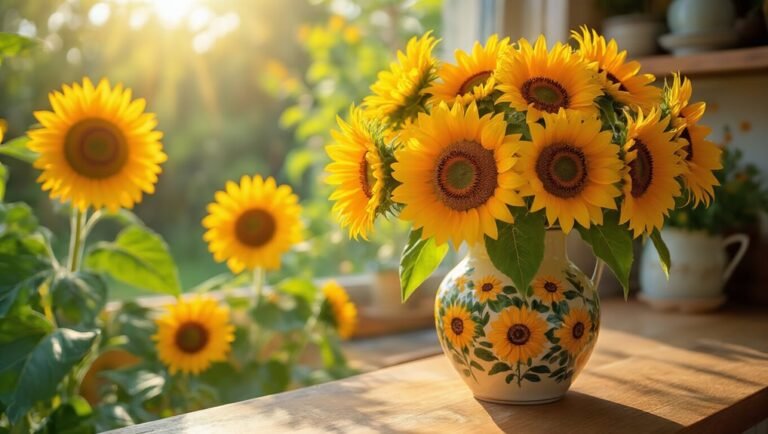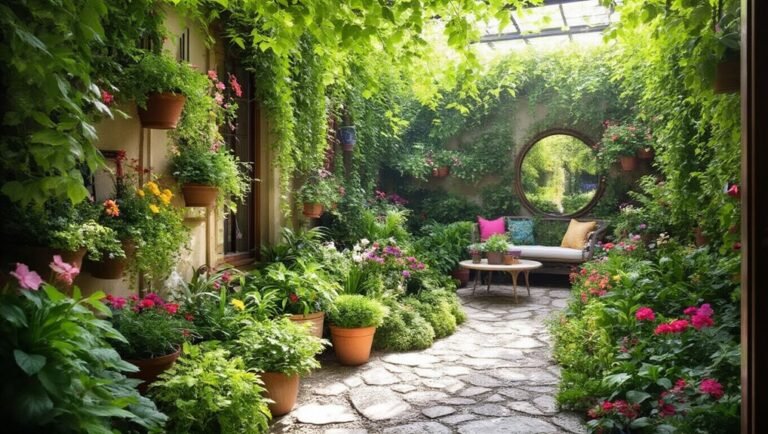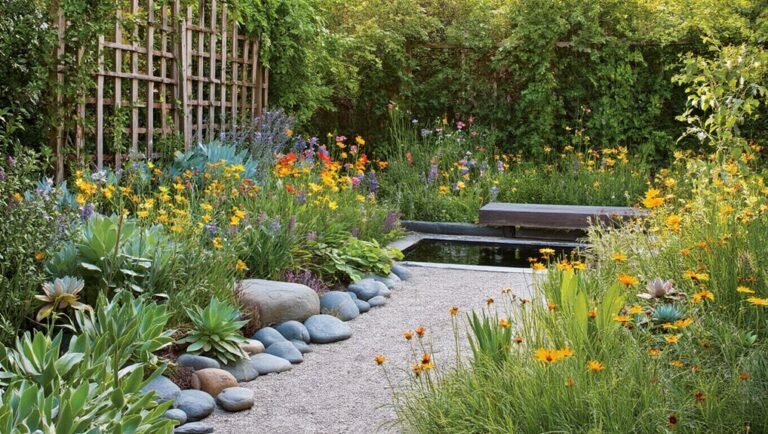To create a beautiful flower garden, start by choosing a sunny spot that gets at least six hours of direct sunlight daily. Select plants that suit your climate and combine various bloom times for continuous color. Test and amend your soil for optimal health, and plan your layout with taller plants at the back. Regular maintenance like watering, deadheading, and pest control is key. There’s more to explore about attracting pollinators and enhancing your garden’s appeal.
Key Takeaways
- Assess your garden’s sunlight exposure and choose flowers that match their light requirements for optimal growth.
- Select a variety of plants with different bloom times and colors to ensure continuous visual interest throughout the seasons.
- Test and amend your soil to ensure it retains moisture and drains well, providing a healthy environment for flowers.
- Regularly maintain your garden by deadheading, pruning, and mulching to promote growth and prevent weeds.
- Attract pollinators by including native plants and providing shelter, enhancing the overall health of your garden ecosystem.
Choosing the Right Location
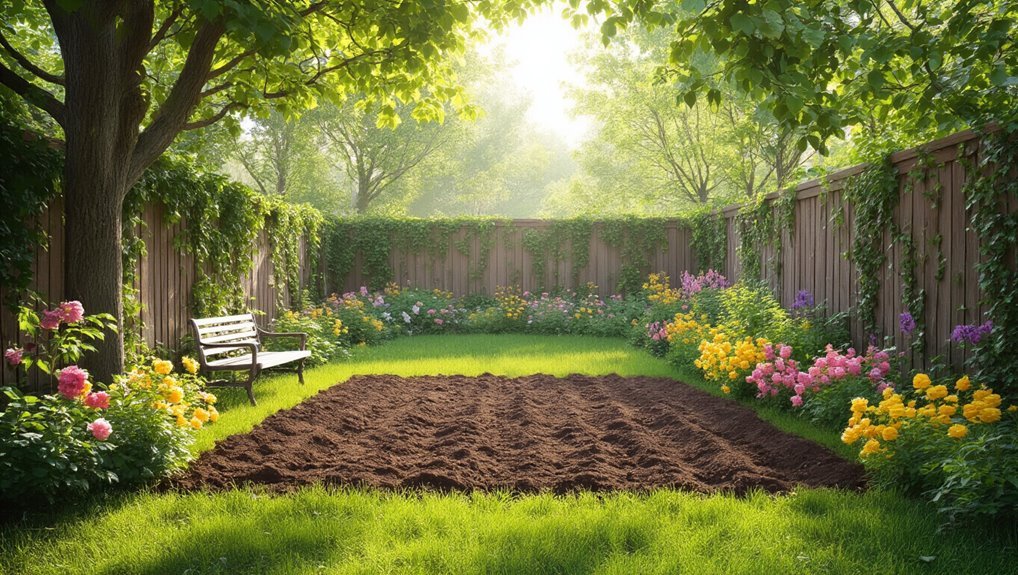
When you’re planning your flower garden, choosing the right location is crucial for success.
Start by assessing the sunlight in your yard. Most flowers thrive in full sun, which means at least six hours of direct sunlight daily. Look for a spot that isn’t shaded by trees or buildings. For optimal plant health, using the best garden soil can make a significant difference in how your flowers grow.
Next, consider the soil quality. You want well-draining soil that retains some moisture, so avoid areas where water tends to pool. If you’re not sure about your soil, a quick test can help.
Lastly, think about accessibility. You’ll want to reach your garden easily for watering, weeding, and harvesting.
For even better results, consider using soil moisture sensors to accurately monitor how much water your garden needs and ensure your flowers thrive.
Selecting the Best Plants
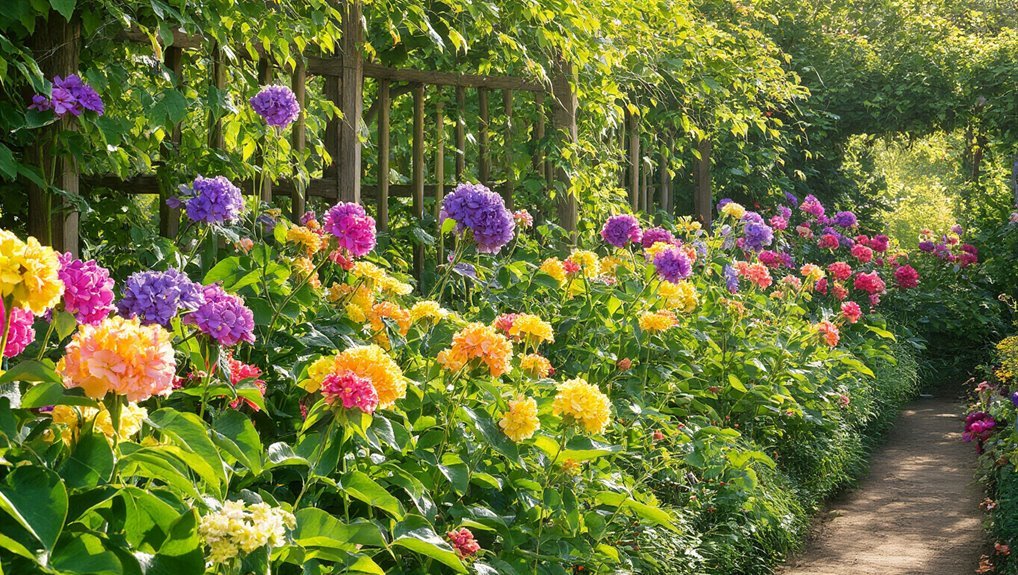
How do you choose the best plants for your flower garden? Start by considering your climate and the amount of sunlight your garden gets. Look for plants that thrive in your area’s conditions.
Think about the bloom time and color palette you want, ensuring a mix of early, mid, and late bloomers for continuous color. If you have a specific theme in mind, like a cottage garden or a formal arrangement, select plants that complement that vision. For more inspiration and guidance, many gardening books offer comprehensive plant selection advice and creative garden design ideas.
Don’t forget about the size and height of the plants; taller varieties should go in the back, with shorter ones in front. Finally, consider maintenance; some plants require more care than others, so choose what fits your lifestyle.
Using a planting calendar can help you plan the best times to sow and transplant your chosen flowers for optimal growth.
Happy planting!
Understanding Soil Requirements
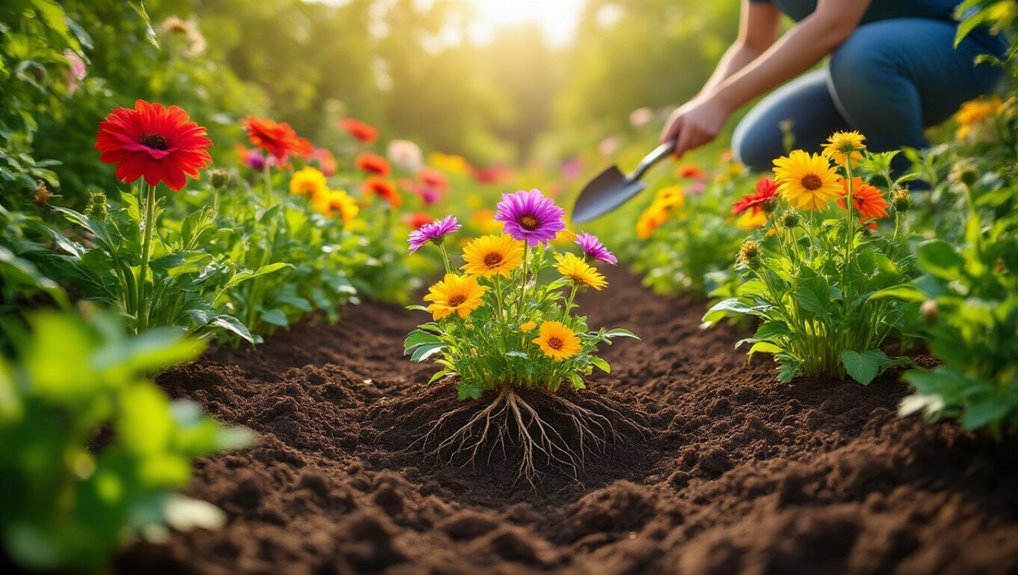
Understanding soil requirements is crucial for creating a thriving flower garden. Start by testing your soil’s pH level; most flowers prefer slightly acidic to neutral soil (pH 6.0 to 7.0). You can purchase a simple test kit at your local garden center.
Next, assess your soil’s texture—loamy soil is ideal because it holds moisture yet drains well. If your soil is too sandy or clay-heavy, consider amending it with organic matter, like compost or aged manure, to improve its structure and nutrient content. For an environmentally friendly way to add nutrients, consider using compost bins to create your own rich compost at home.
Also, ensure your soil has good drainage to prevent root rot. By understanding these basics, you’ll provide your flowers with the right environment to flourish, leading to a stunning garden you can enjoy all season long. Using mulch in your garden can help retain soil moisture, regulate temperature, and suppress weeds, further supporting healthy flower growth.
Ensuring Proper Sunlight
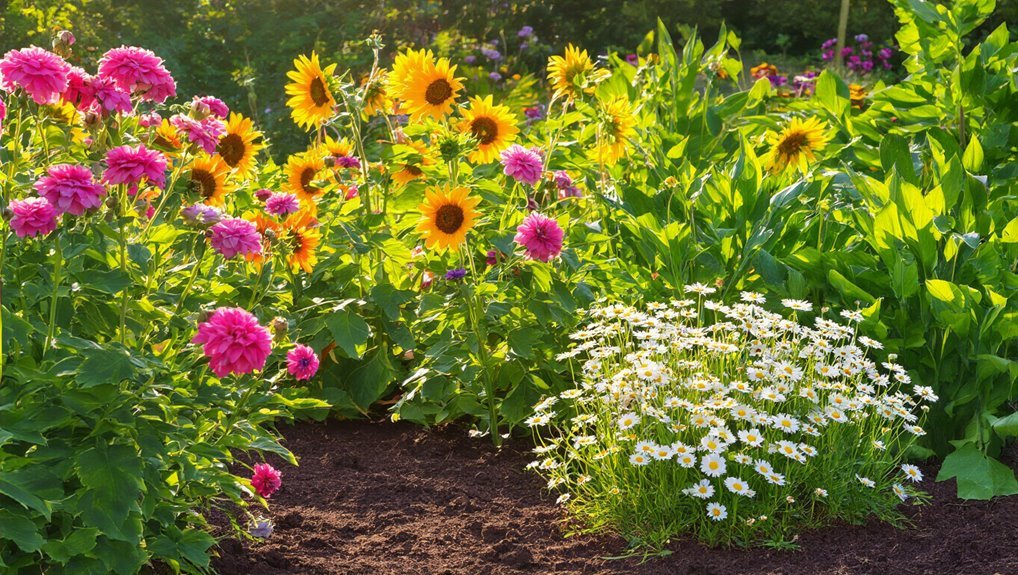
To ensure your flowers thrive, it’s essential to provide them with the right amount of sunlight. Most flowering plants need at least six hours of direct sunlight daily.
Observe your garden throughout the day to identify areas that receive ample light. Pay attention to how sunlight shifts with the seasons, as this can affect where you plant your flowers. For watering needs, many gardeners rely on garden hoses as a convenient and efficient way to keep plants healthy.
If you notice shaded spots, consider choosing shade-tolerant varieties for those areas. Remember, too much sun can also be harmful; some plants prefer partial shade.
As you select your flowers, check their sunlight requirements on the labels. Providing the right amount of light will help your garden flourish, leading to vibrant blooms and healthy plants.
To make sure your flowers stay hydrated, it’s helpful to use watering cans designed for gardeners, which allow you to control the flow and distribution of water efficiently.
Planning Your Garden Layout
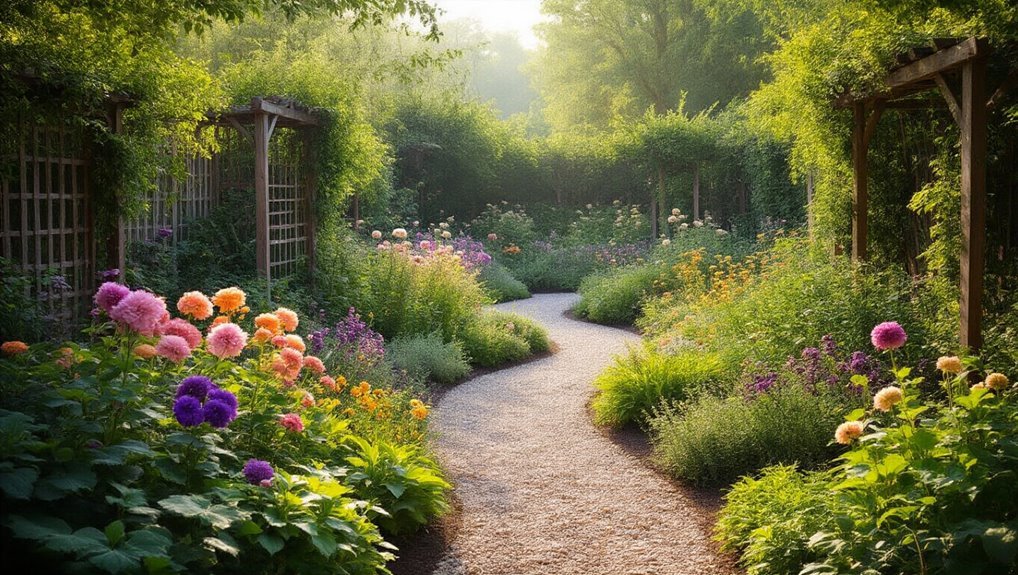
Creating a thoughtful garden layout is crucial for maximizing your flower garden’s potential. Start by sketching a simple plan on paper or using a garden design app. Consider the size and shape of your space, and note where sunlight and shade fall throughout the day. Group flowers with similar light and water needs together for easier maintenance. To make your garden even more versatile, you might want to incorporate raised garden beds for better soil control and easier access.
Use taller plants at the back of borders and shorter ones at the front to ensure every bloom gets noticed. Also, think about pathways for easy access to each section.
Finally, leave some space for future additions or changes, allowing your garden to evolve over time. A well-planned layout sets the foundation for a thriving, beautiful flower garden. To make planning even easier, consider exploring landscape design software or apps that can help you visualize and organize your garden before you start planting.
Incorporating Color and Texture
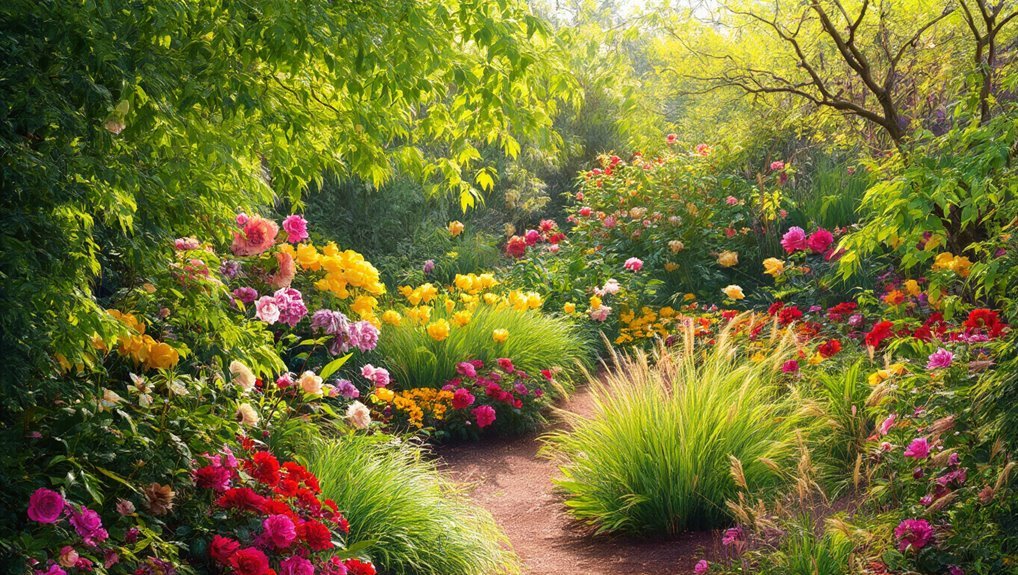
A vibrant flower garden thrives on a harmonious blend of color and texture that captivates the eye and enriches the landscape.
To create this stunning display, think about the following elements:
- Contrasting Colors: Use a mix of complementary colors, like purples and yellows, to create visual interest and draw attention to specific areas of your garden.
- Varied Textures: Incorporate plants with different leaf shapes and sizes, such as the smooth leaves of hostas alongside the feathery fronds of ferns, for a rich tactile experience. For even more lush growth, consider nourishing your plants with plant fertilizer tablets to provide essential nutrients.
- Seasonal Blooms: Choose flowers that bloom at different times, ensuring your garden remains vibrant and colorful throughout the seasons.
For the healthiest and most vibrant results, make sure to nourish your flowers with the best plant food options to support their growth and color.
Maintenance and Care Tips
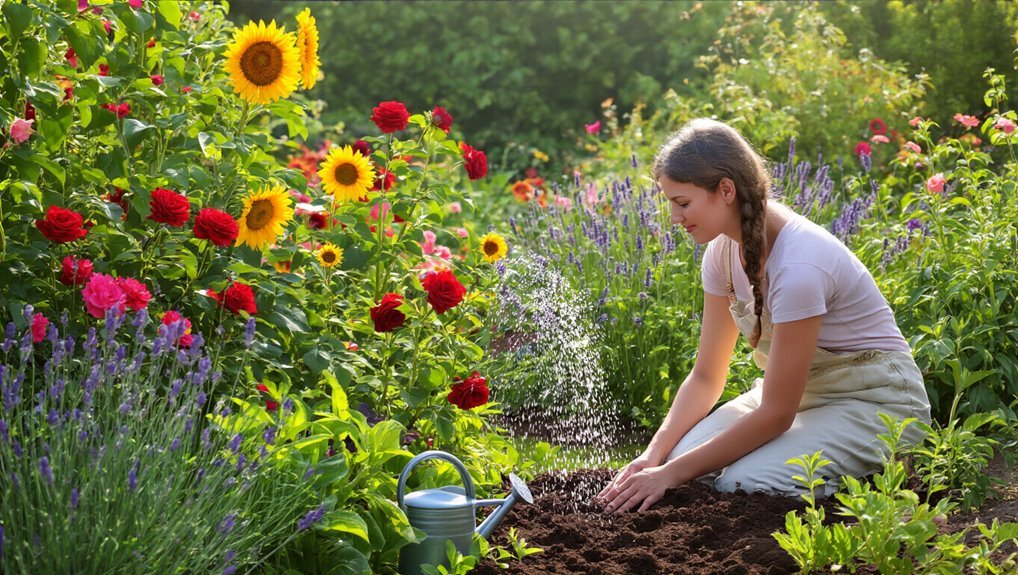
Maintaining a vibrant flower garden requires consistent attention to keep the colors and textures thriving.
Start by watering your plants deeply, preferably in the early morning, to prevent evaporation. Regularly check for weeds, as they compete for nutrients and moisture. To protect delicate blooms and foliage from birds or larger pests, consider adding garden netting over your beds.
Mulching helps retain soil moisture and suppress weeds, so don’t skip this step. Fertilize your flowers according to their specific needs, ensuring you’re using the right type and amount.
Deadheading spent blooms encourages new growth and prolongs flowering. Additionally, inspect your plants for pests and diseases, addressing any issues promptly.
Pruning helps maintain shape and encourages healthy growth. With these care tips, your flower garden will remain lush and inviting throughout the growing season.
To further enhance your garden’s health, consider using Organic Mulching Materials like straw, which improve soil structure and add natural nutrients as they decompose.
Attracting Pollinators and Wildlife
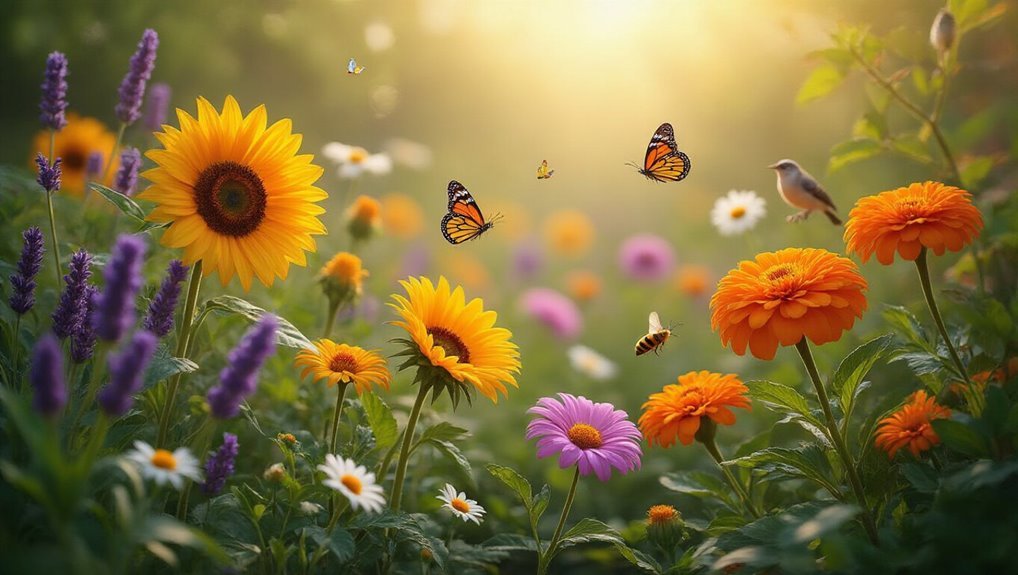
To attract pollinators and wildlife to your flower garden, consider planting a diverse array of flowers that bloom at different times throughout the season.
This variety not only keeps your garden vibrant but also provides a continuous food source for bees, butterflies, and birds. Including decorative birdhouses for gardens can enhance your outdoor space while offering birds a safe and attractive place to nest.
Here are three simple ways to enhance your garden’s appeal:
- Choose native plants: They’re adapted to your local environment and are more attractive to local wildlife.
- Create shelter: Add features like birdhouses, bee hotels, or brush piles to provide safe spaces for wildlife.
- Limit pesticide use: Reducing chemicals helps maintain a healthy ecosystem, allowing beneficial insects to thrive.
Adding bee hotels to your garden can further support solitary bees by offering them a safe place to nest and increasing pollination in your garden.
Seasonal Considerations for Your Garden
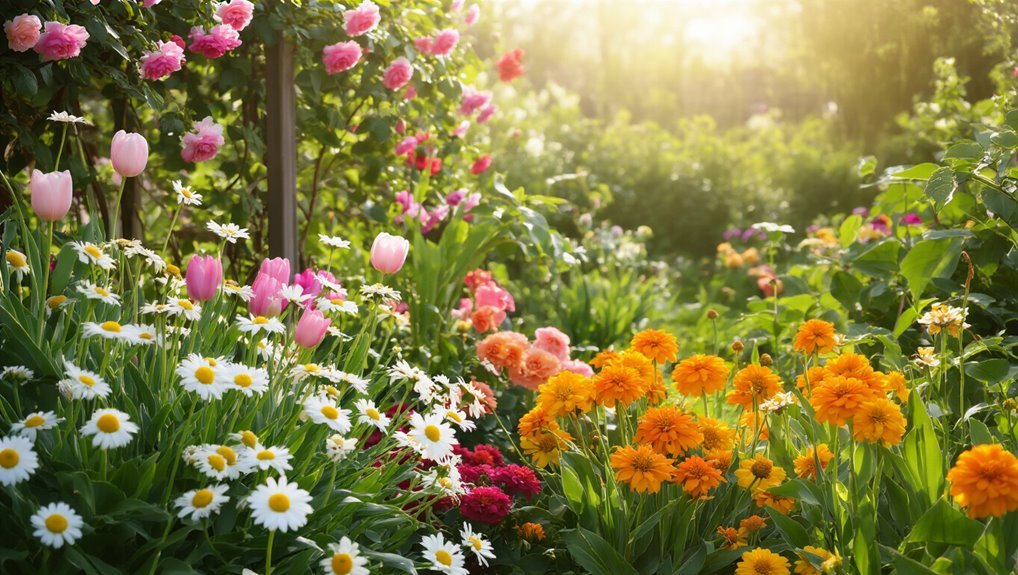
As the seasons change, your flower garden requires adjustments to thrive year-round. In spring, plant bulbs and annuals for vibrant blooms. Summer demands regular watering and deadheading to promote growth. As fall approaches, consider adding perennials and preparing for colder months. Winter isn’t a time to neglect your garden; protect plants with mulch and plan for spring. Starting your flowers with essential seed starting kits can give your garden a strong foundation for success. You can also experiment with Seed Bomb Kits for Guerrilla Gardening to quickly and easily introduce a variety of flowers to your garden.
| Season | Key Tasks |
|---|---|
| Spring | Plant bulbs and annuals |
| Summer | Water regularly, deadhead |
| Fall | Add perennials, prepare |
| Winter | Mulch, plan for spring |
Frequently Asked Questions
How Do I Choose the Right Garden Tools for Planting Flowers?
You’ll want to consider your specific needs and preferences when choosing garden tools. Look for durable, ergonomic options that fit comfortably in your hands. Quality tools make planting flowers easier and more enjoyable for you.
Can I Plant Flowers in Containers Instead of in the Ground?
Sure, you can plant flowers in containers instead of the ground. Just remember, pots won’t magically water themselves! Choose the right size, ensure drainage, and keep those beauties fed and hydrated for a flourishing container garden.
What Are the Best Times of Year to Plant Flowers?
The best times to plant flowers depend on your climate. Generally, spring and fall are ideal for most varieties. Just make sure to check local frost dates to ensure your flowers thrive.
How Do I Prevent Pests From Damaging My Flower Garden?
To prevent pests from damaging your garden, regularly inspect your plants, introduce beneficial insects, and use organic repellents. Keeping your garden clean and healthy will also reduce pest infestations and promote vibrant flowers.
Should I Use Organic or Synthetic Fertilizers for My Flowers?
You might think synthetic fertilizers are more effective, but using organic options nourishes your soil and promotes healthy growth. They’re safer for beneficial insects and the environment, making them a great choice for your flowers.
Conclusion
With the right location, the perfect plants, and proper planning, your flower garden can flourish fantastically. By blending brilliant blooms and beautiful textures, you’ll create a captivating canvas that attracts appreciative eyes. Don’t forget to nurture your garden with consistent care and encourage friendly fauna like butterflies and bees. Embrace seasonal shifts, and watch your floral masterpiece evolve throughout the year. Dive into this delightful endeavor, and you’ll find joy in every petal and bloom!
